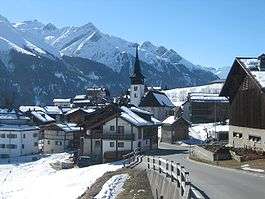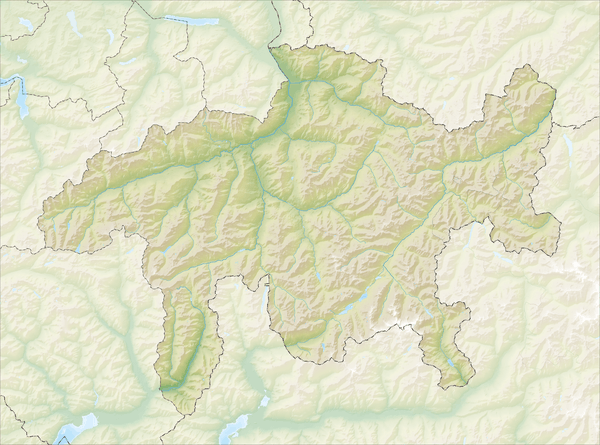Vignogn
Vignogn is a former municipality in the district of Surselva in the canton of Graubünden in Switzerland. The municipalities of Cumbel, Degen, Lumbrein, Morissen, Suraua, Vignogn, Vella, and Vrin merged on 1 January 2013 into the new municipality of Lumnezia.[1]
Vignogn | |
|---|---|
 | |
 Coat of arms | |
Location of Vignogn 
| |
 Vignogn  Vignogn | |
| Coordinates: 46°41′N 9°09′E | |
| Country | Switzerland |
| Canton | Graubünden |
| District | Surselva |
| Area | |
| • Total | 7.90 km2 (3.05 sq mi) |
| Elevation | 1,239 m (4,065 ft) |
| Population (Dec 2011) | |
| • Total | 170 |
| • Density | 22/km2 (56/sq mi) |
| Postal code | 7147 |
| SFOS number | 3604 |
| Surrounded by | Degen, Lumbrein, Obersaxen, Sankt Martin, Suraua |
| Website | www SFSO statistics |
History
Vignogn is first mentioned in 1325 as Vinanne. In 1469 it was mentioned as Viends.[2]
Geography
Vignogn had an area, as of 2006, of 7.9 km2 (3.1 sq mi). Of this area, 57.4% is used for agricultural purposes, while 31.3% is forested. Of the rest of the land, 2.7% is settled (buildings or roads) and the remainder (8.6%) is non-productive (rivers, glaciers or mountains).[3]
The former municipality is located in the Lugnez sub-district of the Surselva district. It consists of the linear village of Vignogn at an elevation of 1,241 m (4,072 ft) at the foot of the Piz Sezner. Until 1983 Vignogn was known as Vigens.[1]
Demographics
Vignogn had a population (as of 2011) of 170.[4] As of 2008, 0.6% of the population was made up of foreign nationals.[5] Over the last 10 years the population has decreased at a rate of -14%. Most of the population (as of 2000) speaks Romansh (88.8%), with German being second most common (10.1%) and French being third ( 0.6%).[3]
As of 2000, the gender distribution of the population was 53.0% male and 47.0% female.[6] The age distribution, as of 2000, in Vignogn is; 11 children or 6.1% of the population are between 0 and 9 years old and 21 teenagers or 11.7% are between 10 and 19. Of the adult population, 26 people or 14.5% of the population are between 20 and 29 years old. 13 people or 7.3% are between 30 and 39, 22 people or 12.3% are between 40 and 49, and 37 people or 20.7% are between 50 and 59. The senior population distribution is 27 people or 15.1% of the population are between 60 and 69 years old, 8 people or 4.5% are between 70 and 79, there are 11 people or 6.1% who are between 80 and 89,and there are 3 people or 1.7% who are between 90 and 99.[5]
In the 2007 federal election the most popular party was the CVP which received 71.4% of the vote. The next three most popular parties were the SVP (13.4%), the FDP (8.7%) and the SP (6.5%).[3]
In Vignogn about 55.1% of the population (between age 25-64) have completed either non-mandatory upper secondary education or additional higher education (either university or a Fachhochschule).[3]
Vignogn has an unemployment rate of 1.06%. As of 2005, there were 36 people employed in the primary economic sector and about 15 businesses involved in this sector. 8 people are employed in the secondary sector and there are 3 businesses in this sector. 18 people are employed in the tertiary sector, with 8 businesses in this sector.[3]
The historical population is given in the following table:[2]
| year | population |
|---|---|
| 1850 | 199 |
| 1900 | 134 |
| 1950 | 204 |
| 2000 | 179 |
Notable residents
- Carmen Casanova, Women's Alpine Skier (born 1980 in Vignogn)
References
- Amtliches Gemeindeverzeichnis der Schweiz published by the Swiss Federal Statistical Office (in German) accessed 2 January 2013
- Vignogn in German, French and Italian in the online Historical Dictionary of Switzerland.
- Swiss Federal Statistical Office Archived January 5, 2016, at the Wayback Machine accessed 25-Nov-2009
- Swiss Federal Statistics Office – STAT-TAB Ständige und Nichtständige Wohnbevölkerung nach Region, Geschlecht, Nationalität und Alter (in German) accessed 3 October 2012
- Graubunden Population Statistics Archived August 27, 2009, at the Wayback Machine (in German) accessed 21 September 2009
- Graubunden in Numbers Archived September 24, 2009, at the Wayback Machine (in German) accessed 21 September 2009
| Wikimedia Commons has media related to Vignogn. |
External links
- Official website (in German)
- Vignogn in German, French and Italian in the online Historical Dictionary of Switzerland.